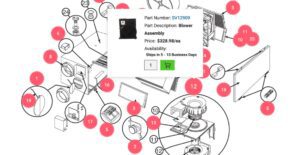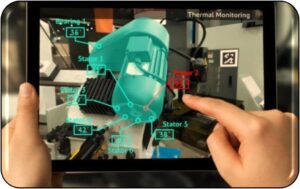
Kathleen Lewarchick
“Visual commerce,” or online buying that uses 360-degree image views, interactive 3D models, and in some cases, augmented reality, has made the jump to B2B ecommerce. Introduced by the gaming world, visual commerce became more mainstream when B2C brands began offering enhanced visual experiences. Think eyewear retailing, where consumers “try on” frames, or furniture buying, where buyers preview products in their virtual home. It was only a matter of time before those experiences appeared in B2B.
How visual commerce helps B2B buyers
Buyers look for clarity as they step through an online customer journey. Ordering and reordering can be straightforward, but increasingly distributors and manufacturers have turned to “solution selling” of interconnected products using a visual approach. Buyers appreciate seeing a more fully integrated list of materials. It removes the guesswork and saves time. Sometimes it even saves them money.
In some categories, visual commerce provides wholesalers (and even their consumers) with engaging experiences. It might be a virtual showroom with curated collections that support full online buying. Other times it is a mixed-use tool, a digital assist: buyers peruse fixtures and materials in a real showroom and place items in an online cart, on a device, as they shop. This can save buyers time and it can be a wonderful way to cross-sell them throughout the customer journey.
New technology tools
One tool — exploded-view diagrams, or schematics showing parts together — was a mainstay for engineers. But they are more common now throughout B2B ecommerce. Buyers can now see the entire solution, both holistically and individually, and order with them. Per the parts diagram below, the exploded view integrates with the order management system. See a part that you need? Check. See the whole solution? Check, check. In either case, just click and place it in the cart.

An exploded-view diagram, which is becoming more common in B2B ecommerce, lets buyers view and click to buy individual parts of complex equipment.
One B2B company incorporated this technology into their user experience flow. The goal was twofold:
- to make it easier for B2B sellers in their organization to explain larger, integrated solutions; and
- to make it easier for their customers, B2B procurement teams, to visualize the outcome.
By creating an integrated visual tied to the company’s order management system, they reduced steps in the customer journey. As the ecommerce manager says, “There’s a wonderful moment when buyers say: ‘Aha! I see how it all works.’ We want to delight and relieve buyers during the process.”
While not all B2B categories are a match for transactional visual commerce, other augmented reality tools are on the cusp of changing the way that overall B2B business performs. Again, driven by experiences in gaming, buyers like MRO (maintenance, repair and operations) engineers can now don A/R headgear or use tablets to “see” solutions in their natural environment. As a result, they may uncover potential barriers earlier in the buying process, maybe even prior to ordering. This accelerates the knowledge build and helps save time and money with returns.


MRO engineers use visual commerce to view products in their natural environment before placing an order.
Preparing for the future
Visual commerce may never fully replace traditional ecommerce, just as “voice commerce” hasn’t become the dominant way to place B2B orders yet. However, visual commerce will continue to be incorporated into many facets of B2B digital commerce given the appetite that online users have for strong visuals. A great place for your organization to start is with a strategic discussion about use cases. These provide the foundation alongside good product data, and with technologies like Digital Asset Management systems, you evolve toward the Visual Commerce experiences that your customers increasingly expect.
About the author
Kathleen Leigh Lewarchick is the VP of Marketing for Xngage LLC, a B2B digital commerce services company with more than 60 clients across the industrial trades. She is the former PURELL® Hand Sanitizer Brand Director, has co-created automated replenishment products with Amazon Business, and created telehealth solutions for a company that she later helped sell to CVS Health.
Sign up
Sign up for a complimentary subscription to Digital Commerce 360 B2B News, published 4x/week. It covers technology and business trends in the growing B2B ecommerce industry. Contact editor Paul Demery at [email protected] and follow him on Twitter @pdemery.
Follow us on LinkedIn and be the first to know when Digital Commerce 360 B2B News publishes content.
Favorite